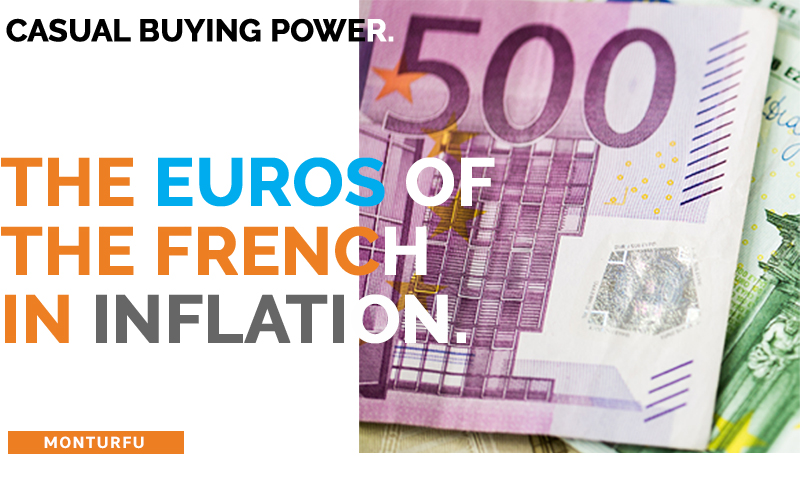CASUAL PURSHASING POWER.
FRENCH PEOPLE’S
EUROS IN INFLATION.
Before the energy price surge, that is in July 2021, GfK’s Purchasing Power Europe 2021 study ranks France 15th out of 42 countries surveyed. Nevertheless, the figures show an increase in purchasing power. Specifically, it shows +6.48%, namely 20,662 euros in 2021 against 19,404 euros in 2020. Thus, Paris and Boulogne-Billancourt stand out from the rest of France.
And they do have an individual purchasing power of 34,536 and 33,525 euros. In these two cities, the purchasing power is two thirds higher than the national average and more than double the European average.
Casual purchasing power in France.
The European average is 15,055 euros, but it has increased by 1.9% over the same period.
It is clear that the disparities within the same territory are striking. In France, the department of Seine-Saint-Denis, 93, has an average purchasing power of 14,086 euros per inhabitant. This is – 184 euros per year compared to 2019 and a third less net income than the national average. While opposite Paris, then Boulogne-Billancourt are increasing respectively by 12%, +3700 euros and +6.5%, +2000 euros.
Prices of products and services.
At the end of the summer of 2021, the price of raw materials is skyrocketing, particularly oil and gas, which in turn is pulling electricity down, and this is starting to weigh on the wallets of the French.
As a result, 75% of French people feel that their purchasing power is shrinking, according to an Odoxa survey for France Bleu. Indeed, since this date, the prices of products and services that we consume daily are inexorably increasing. Thus, to compensate for the generalized rise in prices, a tax-free inflation allowance of 100 euros will soon be paid to 38 million French people.
The general price trend over the past few years.
Since 2015, consumer prices have increased by 7%. This is very largely due to energy prices, particularly gas prices, which between August and September 2021 grew by 14.9%.
Sébastien Faivre, Head of the Consumer Price Division at INSEE, the French National Institute for Statistics and Economic Studies.
Casual purshasing power in Europe.
Looking at the figures, the per capita purchasing power of the European Top 10 is quite high. Indeed, it is 55% higher than the European average. The United Kingdom is in 10th place with 23,438 euros, Germany is 8th with 23,637 euros, Luxembourg 3rd with 35,096 euros, Switzerland 2nd with 40,739 euros. And at the top of the list, Liechtenstein has a per capita purchasing power of 64,629 euros, which is more than 4 times the European average. On the other hand, the ratio between the purchasing power of the inhabitants of Ukraine and Liechtenstein is 1 to 34.
Definition of buying power :
Purchasing power is the quantity of goods and services that an income can buy. Purchasing power is therefore derived from the level of income and the level of prices. The evolution of purchasing power is therefore the difference between the evolution of household income and the evolution of prices. If the increase in income is greater than the increase in prices, purchasing power increases. Otherwise, it decreases.
What is disposable income ?
This is the income from activities, salaries, fees, interests, dividends, rents received plus the social benefits received, minus the taxes paid.
Casual purshasing power : Price evolution.
INSEE calculates the consumer price index in France. In fact, this parameter makes it possible to assess the variation in the general level of prices of goods and services consumed by households between two periods taken into consideration. Thus, when prices are on the rise, we speak of inflation. Thus, the prices of consumer products for households increase on average.
Historically, it is in 2012 that the purchasing power of French households fell for the first time by -1% in 30 years. With a slowdown in wages and an increase in compulsory levies. A small decrease in consumption and a contraction or decrease in savings followed.
The evolution from 1974 to 2006.
The economic recovery is clear and real in France. By the end of the third quarter of 2021, the French economy will already be back to its March 2020 level. State authorities are forecasting an unemployment rate of 7.6% at the end of 2021. Moreover, this is its lowest level since 2008. On the other hand, the State will disburse at the end of 2021, as planned at the beginning of the Covid-19 crisis, 70% of the 100 Md€ in the framework of the France Relance plan.
Casual purchasing power : who benefits from the inflation allowance ?
-
Employees ;
-
public servants;
-
self-employed persons;
-
job seekers;
-
disabled persons and recipients of social benefits;
-
Retired persons, including early retirees;
-
students with scholarships and those without a job who receive housing subsidies;
-
young people with a professional activity, apprentices as well as young people in a support program towards employment;
-
beneficiaries of minimum social benefits, RSA, ASS, AAH, RSO, PreParE, ASI, including disabled workers in ESAT establishments and services.
Casual purchasing power : how will recipients receive this inflation allowance ?
First of all, the State grants employers and any other organization a payment aid on the social contributions paid to the URSSAF on their social declaration following the payment of the allowance. So on the one hand, the employers take care of the payment of the 100 euros for employees and public agents. And on the other hand, the following organizations will compensate :
-
the Urssaf for self-employed people ;
-
the pension fund for retired people;
-
the CROUS for students;
-
the Pôle emploi for job seekers;
-
the Mutualité sociale agricole, MSA, for farmers
-
the family allowance fund, CAF, for recipients of minimum social benefits.
Casual purchasing power : The payment schedule.
This allowance is in addition to other devices already in place including the exceptional energy voucher, 5.8 million households and the tariff shield to curb the rise in electricity and gas prices. The schedule is spread over December 2021 and February 2022. We have therefore for the :
-
Employees under private law, as of December 2021.
-
Non-salaried workers, as of December 2021.
-
Employees of the State and its operators, in January 2022.
-
Local government employees, in January 2022.
-
Hospital workers, in January 2022.
-
Students receiving scholarships, in December 2021.
-
Non-scholarship students receiving housing subsidies, in January 2022.
-
Job seekers, in January 2022.
-
Recipients of social benefits, in January 2022.
-
Invalids, in January 2022.
-
Retirees, in February 2022.
Buying power.
Across the Atlantic, American incomes are expected to rise by 6% in 2020 despite the impact of the pandemic. Nevertheless, in France, we are seeing drops in income here and there, particularly among lower middle class employees and self-employed contractors.
Casual purshasing power in France.
However, on average, purchasing power is holding up very well, thanks to government measures such as the solidarity fund and partial activity. Finally, because they cannot consume, the French are saving enormously, even if there are disparities in this area. The financial savings rate has happily increased from 4.6% of disposable income in 2019 to 12.1% last year. The French are putting aside 111 billion euros more in 2020 than in 2019 !
The speed at which they spend this pot of money will largely determine the pace of economic recovery in the coming quarters. On the business side, the picture is not good. The business margin rate has fallen by 4 points to 29.3% in 2020 after 33.2% in 2019, the lowest level since 1985. Mechanically, the self-financing capacity of companies is plummeting.
Ok de-MEDEIROS
SOURCES : https://www.gouvernement.fr/une-indemnite-inflation-pour-proteger-le-pouvoir-d-achat-des-francais-face-a-la-hausse-des-prix, https://www.economie.gouv.fr/facileco/pouvoir-achat-definition#, https://www.economie.gouv.fr/facileco/comment-mesurer-pouvoir-achat, https://www.economie.gouv.fr/facileco/mieux-comprendre-chiffres-pouvoir-achat, https://www.bfmtv.com/economie/economie-social/france/avec-un-pouvoir-d-achat-de-20-662-euros-par-habitant-la-france-se-classe-au-15e-rang-europeen_AV-202111040192.html, https://www.insee.fr/fr/metadonnees/source/indicateur/p1653/description, https://www.lemonde.fr/politique/article/2021/10/28/comment-le-pouvoir-d-achat-est-devenu-la-grande-peur-du-gouvernement_6100217_823448.html, https://www.lesechos.fr/economie-france/conjoncture/covid-malgre-la-crise-le-pouvoir-dachat-moyen-des-francais-na-pas-recule-en-2020-1293803, https://www.youtube.com/watch?v=C7EfqAitbxY, https://www.youtube.com/watch?v=1ErlKIZ9IqM, https://www.youtube.com/watch?v=Ja_3BnLH5Zg






Laisser un commentaire